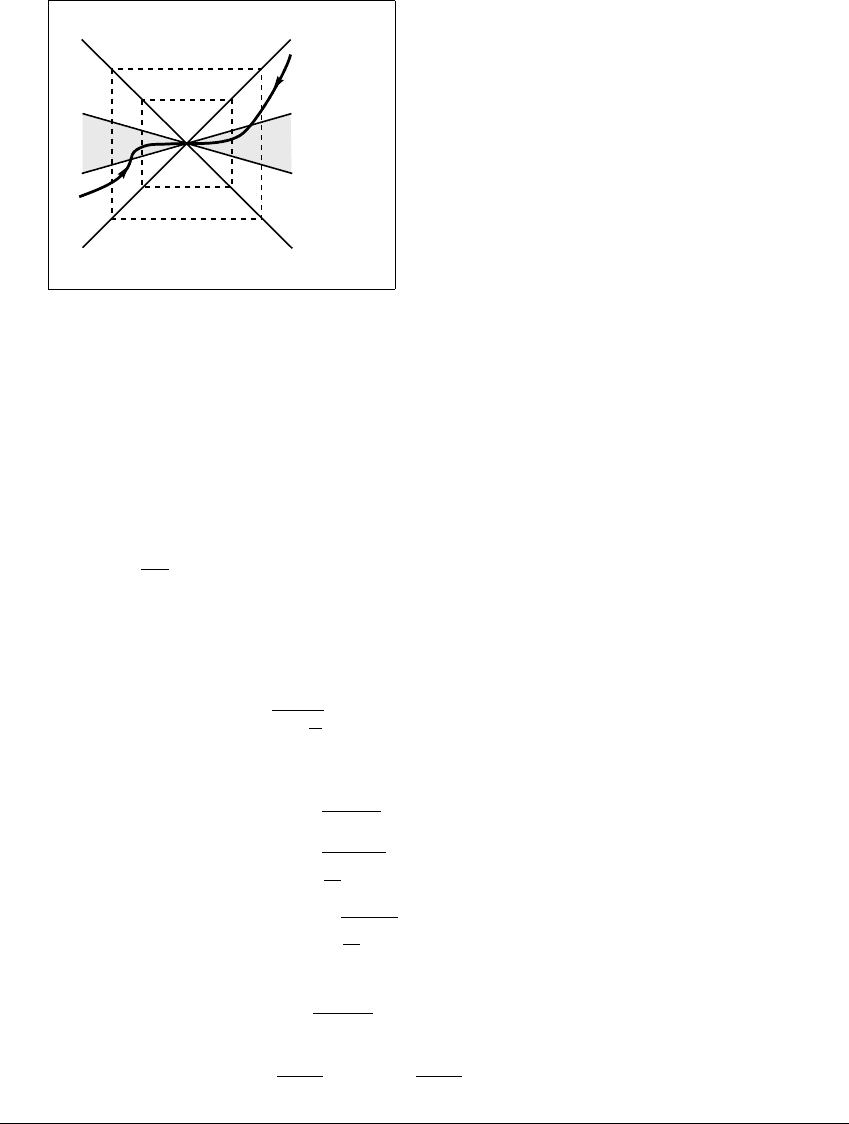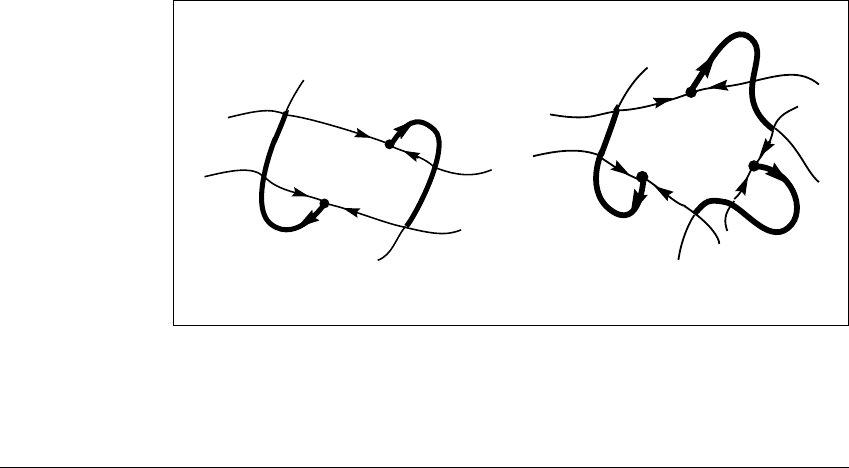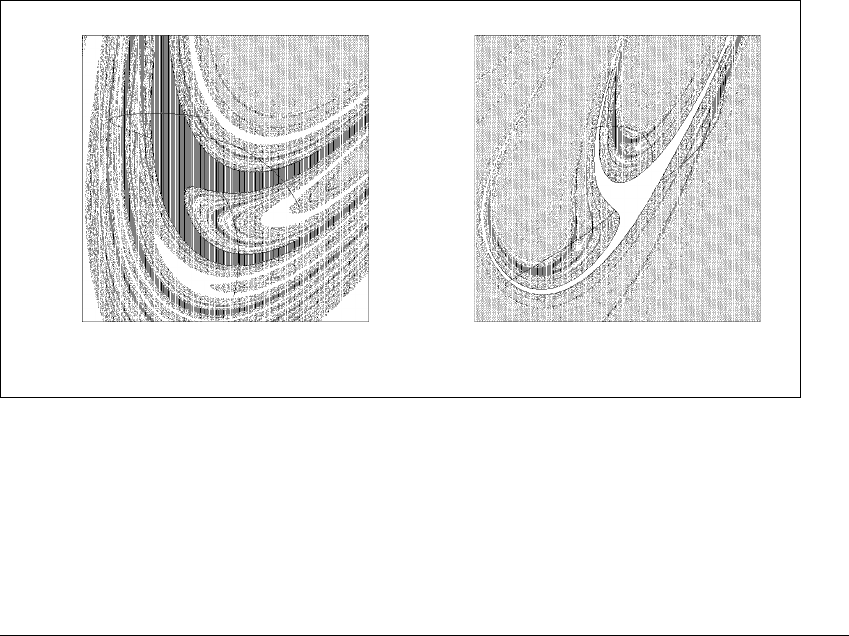Alligood K., Sauer T., Yorke J.A. Chaos: An Introduction to Dynamical Systems
Подождите немного. Документ загружается.


10.4 PROOF OF THE S TA BLE M ANIFOLD T HEOREM
y = x
y = kx
y = -kx
y = -x
B
B
k
Figure 10.24 Cones containing the stable manifold.
The proof of Lemma 10.17 shows that for any k ⬎ 0 the local stable set enters the
cone determined by the lines y ⫽⫾kx.
Lemmas 10.13–10.16 show (among other properties) that S
B
is contained
within the cone determined by the lines y ⫽⫾x. See Figure 10.24. If we decrease
the magnitude of the slope of these lines, we can similarly show that there is a
(perhaps smaller) square B
k
such that S
B
k
lies in the cone determined by y ⫽⫾kx,
0 ⬍ k ⬍ 1. Thus
(x)
x
→ 0, as x → 0. This is the idea behind the proof of Lemma
10.17.
Lemma 10.17
(0) ⫽ 0.
Proof: Given k ⬎ 0, choose
␦
⬎ 0 (the width of the square B
k
)small
enough so that
⑀
⬍ (u ⫺ 1) 2
!
1 ⫹
1
k
2
. (Recall that
␦
and
⑀
are related as in
Lemma 10.11.) Let p ⫽ (x, y) be a point in B
k
but outside the y ⫽⫾kx cone. The
vertical position of f(p) can be approximated by Lemma 10.11, as follows:
|f(p)
y
| ⱖ u|y| ⫺
⑀
x
2
⫹ y
2
ⱖ u|y| ⫺
⑀
"
y
2
k
2
⫹ y
2
⫽ |y|
u ⫺
⑀
"
1
k
2
⫹ 1
⬎ |y|
u ⫺
(u ⫺ 1)
2
⫽ |y|
u ⫹ 1
2
⫽ |p
y
|
u ⫹ 1
2
.
429

S TA B LE M ANIFOLDS AND C RISES
Therefore, points outside the y ⫽⫾kx cone have y-coordinates that in-
crease by a factor of
u⫹1
2
⬎ 1 per iteration, and so eventually move out of the
␦
-box B
k
. By the definition of local stable set, S
B
k
is in the y ⫽⫾kx cone.
The definition of derivative of
(x) at 0 is lim
x→0
(x)
x
. Since this ratio is
bounded between ⫺k and k for x near 0, for arbitrarily small k ⬎ 0, the limit exists
and equals 0.
10.5 STABLE AND UNSTABLE MANIFOLDS
FOR
HIGHER DIMENSIONAL MAPS
The Stable Manifold Theorem which is proved in Section 10.4 is for saddles in
the plane. Actually, any hyperbolic periodic point has a stable and an unstable
manifold. Recall that a periodic point of period k is called hyperbolic if Df
k
at
the point has no eigenvalues with absolute value 1. The definitions of stable and
unstable manifolds for these points are identical to Definition 2.18 for saddles in
the plane.
Definition 10.18 Let f be a smooth one-to-one map on ⺢
n
, and let p be
a hyperbolic fixed point or hyperbolic periodic point for f.Thestable manifold
of p, denoted
S(p), is the set of points x 僆 ⺢
n
such that |f
n
(x) ⫺ f
n
(p)| → 0 as
n →
⬁
.Theunstable manifold of p, denoted
U(p), is the set of points x such
that |f
⫺n
(x) ⫺ f
⫺n
(p)| → 0 as n →
⬁
.
The other two types of hyperbolic fixed points for maps of the plane are
sinks and sources. For a fixed point p in the plane, if both eigenvalues of Df(p)are
of absolute value less than one, then p is a sink, and the stable manifold contains
a two-dimensional
⑀
-neighborhood of p. In this case, the entire stable manifold
is a “two-dimensional manifold”. In general, a k-dimensional manifold in ⺢
n
(or
a k-manifold) is the image of a smooth, one-to-one function of ⺢
k
into ⺢
n
. Thus
a two-manifold is a smooth surface.
The unstable manifold of a sink p in ⺢
2
is only the point p itself (a 0-
dimensional manifold). In the case of a repeller in ⺢
2
, in which Df(p) has two
eigenvalues outside the unit circle, the stable manifold is only p itself, while the
unstable manifold is a two-manifold (which in this case is a two-dimensional
subset of the plane).
430

10.5 STA B L E A N D U NSTABLE M ANIFOLDS FOR H IGHER D IMENSIONAL M APS
E XAMPLE 10.19
Let f(x, y, z) ⫽ (⫺3x, .5y, ⫺.2z). Notice that f
k
(0,y,z) ⫽ (0, (.5)
k
y,
(⫺.2)
k
z). Therefore, lim
k→
⬁
|f
k
(0,y,z)| ⫽ 0, and the stable manifold of the
fixed point (0, 0, 0) is seen to be the (y, z)-plane. The unstable manifold is the
x-axis, since f
⫺k
(x, 0, 0) ⫽ ((⫺3)
⫺k
(x), 0, 0).
There is a higher-dimensional version of Theorem 10.1. For a hyperbolic
fixed point p of a higher-dimensional map, the stable manifold will have the same
dimension as the subspace of ⺢
n
on which the derivative contracts; that is, the
dimension is equal to the number of eigenvalues of Df(p) that have absolute value
strictly smaller than 1, counted with multiplicities. This subspace, the eigenspace
corresponding to these eigenvalues, will be tangent to the stable manifold at p.
Similarly, the unstable manifold has dimension equal to the number of eigenvalues
of Df(p) with absolute value strictly larger than 1, counted with multiplicities;
the linear subspace on which Df(p) expands is tangent to the unstable manifold
at p.
E XAMPLE 10.20
Let f(x, y, z) ⫽ (.5x, .5y, 2z ⫺ x
2
⫺ y
2
). The origin is the only fixed point
of f, and its eigenvalues are 0.5, 0.5, and 2. The linear map Df(0) is contracting
on the (x, y)-plane and expanding on the z-axis. The (x, y)-plane, however, is
not the stable manifold for 0 under the nonlinear map f, as Exercise 10.6 shows.
✎ E XERCISE T10.6
Let f(x, y, z) ⫽ (.5x, .5y, 2z ⫺ x
2
⫺ y
2
).
(a) Show that
U(0)isthez-axis.
(b) Show that
S(0) is the paraboloid 兵(x, y, z):z ⫽
4
7
(x
2
⫹ y
2
)其.
431

S TA B LE M ANIFOLDS AND C RISES
☞ C HALLENGE 10
The Lakes of Wada
C
ONSIDER THE TWO open half-planes L ⫽ 兵(x, y):x ⬍ 0其 and R ⫽ 兵(x, y):
x ⬎ 0其. Each of the two regions has a set of boundary points consisting of the
y-axis. Therefore, any boundary point of either of the two regions is a boundary
point of both regions. Can the same thing be done with three regions? It means
getting each boundary point of any one of the three regions to be a boundary
point of both of the others as well. A little thought should persuade you that such
sets will be a little out of the ordinary.
In 1910 the Dutch mathematician L.E.J. Brouwer gave a geometric con-
struction of three regions such that every boundary point is a boundary point of
all three regions. Independently, the Japanese mathematician Yoneyama (1917)
gave a similar example. Yoneyama attributed the example to “Mr. Wada”. This
example is described in (Hocking and Young, 1961); they called the example the
“Lakes of Wada”.
The first three steps in the construction of this fractal are shown in Figure
10.25. Start with an island of diameter 1 mile. The first lake is the exterior, white
region, and the other two are shaded gray and black. Now the excavation begins.
From the exterior region, dig a canal so that every point of land (the island) lies
Figure 10.25 Lakes of Wada.
432

C HALLENGE 10
no more than 1 2 mile from the white canal. Second, dig a gray canal so that no
land lies more than 1 3 mile from it. Third, dig a black canal so that no land lies
more than 1 4 mile from black water. Next, go back and extend the first (white)
canal so that no land lies more than 1 5 mile from it (we have not shown this
step). Continue in this way. Of course, the three lakes must never intersect. Be
sure to pay the bulldozer operator by the amount of dirt moved and not by the
mileage traveled by the bulldozer. In the limit of this process, the area of the
remaining land is 0. Each shore point of any of the lakes is also a shore point for
both of the other lakes.
As originally presented, the Lakes of Wada have nothing to do with dy-
namical systems. Although we have seen basins of attraction with extremely
complicated, even fractal, boundaries, it is hard to imagine that such a configura-
tion of three basins could exist for any but the most contrived dynamical systems.
In this challenge, we present special trapping regions, called basin cells, whose
boundaries are formed by pieces of stable and unstable manifolds, to show that
“Wada basins” appear to exist in simple dynamical processes. We begin with a
few definitions of topological terms.
Let A be a subset of ⺢
n
. (Later concepts will pertain only to subsets of the
plane.) The boundary of A, denoted bd(A), is the set of points that have both
points in A and points not in A arbitrarily close to them. Specifically, x is in
bd(A) if and only if for every
⑀
⬎ 0, the neighborhood N
⑀
(x) contains points in
A and points not in A. Boundary points may be in A or not. For example, the
sets D
c
⫽ 兵x : |x|
2
ⱕ 1其 (the closed unit disk) and D
o
⫽ 兵x : |x|
2
⬍ 1其 (the open
unit disk) both have the same boundary; the unit circle C ⫽ 兵x : |x|
2
⫽ 1其. The
interior of A, denoted int(A), is the set of points in A that have neighborhoods
completely contained in A. Specifically, x is in int(A) if and only if there is an
⑀
⬎ 0suchthatN
⑀
is a subset of A. Notice that int(A)andbd(A) are disjoint
sets.
✎ E XERCISE T10.7
Show: int(D
c
) ⫽ D
o
.
AsetA is called open if it is equal to its interior. An open set does not
contain any boundary points. Assuming that A is an open set, we say a point y
in bd(A)isaccessible from A if there is a curve J such that y is an endpoint of
J, and all of J except y is in A. For our example of the disk, all points in bd(D
o
)
are accessible from D
o
. A somewhat more interesting example is shown in Figure
10.26. There the boundary of the open set U is shown to wind around two limit
433

S TA B LE M ANIFOLDS AND C RISES
U
J
y
Figure 10.26 The open set
U
winds around the circles infinitely many times.
The point shown is accessible from U since it is the end of a curve contained in U.
Every point on the boundary of U is accessible except for those points on the limit
circles (the dashed circles).
circles. (The figure is intended to represent an infinite number of windings of the
boundary around these limit circles.) All points on the boundary, except the limit
circles, are accessible from U. The circles, while in bd(U), contain no points
accessible from U.
Now we introduce dynamics to the situation. Let F be a one-to-one smooth
map of the plane. Recall that a trapping region is a bounded set Q, with int(Q)
not the empty set, with the property that F(Q) is a subset of Q and F(Q)isnot
equal to Q.Thebasin of a trapping region Q, denoted bas(Q), is the set of all
points whose trajectories enter int(Q). Those trajectories then remain in int(Q).
Step 1 Show that if Q is a trapping region, a trajectory that enters Q must
stay in Q for all future iterates. [Hint: If a set A is a subset of B,theF(A)isa
subset of F(B).]
Step 2 Prove two topological properties of basins:
(1) Show that bas(Q) is an open set. [Hint: Given x in bas(Q), let j be a
positive integer such that F
j
(x)isinint(Q). Use the continuity of F
j
to obtain
the result.]
(2) A set A is called path connected if, given any two points x and y in A,
there is a path contained in A with endpoints x and y. (Recall that a path is
a continuous function s :[0, 1] → ⺢
2
.) Show that if Q is path connected, then
bas(Q) is path connected.
434

C HALLENGE 10
Q
p
1
p
2
Q
q
2
q
1
q
3
(a) (b)
Figure 10.27 Basin cells.
In (a) a period-two orbit 兵p
1
,p
2
其 “generates” the cell, while in (b) a period-three
orbit 兵q
1
,q
2
,q
3
其 generates the cell. Notice that basin cells cannot exist if there are
no homoclinic points.
The definition of basin cell is illustrated in Figure 10.27, where we see a
four-sided cell with a period-two point on the boundary and a six-sided cell with
a period-three point on its boundary. A cell is a region Q (homeomorphic to a
disk) whose boundary is piecewise smooth and consists of a finite number of pieces
of stable and unstable manifold of some orbit. Specifically, for a periodic orbit p
of period k, a cell is a planar region bounded by 2k sides: included among these
sides are pieces of both branches of the k stable manifolds as they emanate from
the k points in the orbit together with k pieces of unstable manifolds, one from
each of the k points in p. We denote by Q
s
the union of the points in p together
with points on the pieces of stable manifolds in the boundary of Q, and by Q
u
,
the union of points in pieces of unstable manifolds in the boundary that are not
already points of Q
s
. Then Q
s
and Q
u
are disjoint sets whose union is bd(Q).
In order to be able to verify whether a cell is a trapping region, the following
is useful and almost obvious, but is not easy to show:
If F(bd(Q)) is in Q,thenF(Q)isinQ.
Step 3 Show that a cell Q is a trapping region if and only if F(Q
u
)isa
subset of Q. Sketch an example of a cell that is not a trapping region.
A cell that is a trapping region is called a basin cell. From now on, we assume
that Q is a basin cell and investigate bas(Q) and its boundary. The concept of
basin cell was introduced and developed in (Nusse and Yorke, 1996).
435

S TA B LE M ANIFOLDS AND C RISES
Proposition 1 describes the fundamental structure of basin boundaries.
When there are accessible periodic orbits, then all the accessible boundary points
are on stable manifolds. Although we prove the theorem only for basins with
basin cells, the result holds for a large class of planar diffeomorphisms. See, for
example, (Alligood and Yorke, 1992).
Proposition 1. Let Q be a basin cell and let x be in bd(bas(Q)). If x is accessible
from bas(Q), then x is on the stable manifold of p.
The proof of Proposition 1 is given in Steps 4, 5, and 6.
Step 4 Let x be in bd(bas(Q)) and denote F
n
(x)byx
n
. Show that x is
accessible from bas(Q) if and only if each x
n
,n⫽ 1, 2, 3,...,is accessible from
bas(Q). (The fact that bd(bas(Q)) is invariant under F should be included in the
proof.)
We can assume x is not a point of the orbit p, since such points are trivially
in the stable manifold of p. Let U be the union of the segments of unstable
manifold that are on bd(Q)(thesetQ
u
) together with the pieces of unstable
manifold that connect these segments to the orbit p. (See Figure 10.28.) We
assume further that x is not in U. (If it is, then for some positive integer n,the
point x
n
is not in U, and we can prove the result for x
n
.)
p
1
p
2
U
q
2
q
1
q
3
U
(a) (b)
Figure 10.28 The sets
U
formed by pieces of unstable manifolds.
Segments of the unstable manifolds in the boundary of a cell, together with the
pieces of the manifolds needed to connect them to the periodic points make up the
set U.
436

C HALLENGE 10
Step 5 Since x is accessible from bas(Q), there is a curve J that is con-
tained in bas(Q) except for its endpoint which is x. Show that J can be chosen
so that it does not intersect U. Then prove that F
n
(J) does not intersect U, for
n ⫽ 0, 1, 2,....
Step 6 Let y denote a point in bas(Q)andinJ. We can choose n so that
F
n
(y) is in the interior of Q. (Why can we do this?) Show then that the entire
curve F
n
(J)isinQ for this n. Conclude that F
n
(x) is on the stable manifold of p.
Proposition 2. The accessible points are dense in the boundary of bas(Q).
Step 7 Prove Proposition 2. [Hint: On the straight line between a basin
point and a boundary point, there is an accessible (boundary) point.]
Proposition 3. If the unstable manifold of the orbit p that generates the cell Q
enters another basin B
2
, then every point in the boundary of bas(Q)isalsointhe
boundary of B
2
.
⫺0.4
⫺0.7
0.65 0.95
(a)
0
⫺1.5
01.5
(b)
Figure 10.29 Basin cells for H
´
enon maps.
Parameters are set at a ⫽ 0.71 and b ⫽ 0.9. In (a) initial segments of unstable
manifolds emanating from a period-three accessible orbit are shown. The orbit is
accessible from the dark gray basin. The unstable manifolds intersect each of two
other basins, shown in light gray and white. Therefore, the gray basin is a Wada
basin. In (b) a similar configuration is shown for the basin indicated in white. The
boundary of the white basin is also the boundary of the dark gray and the light gray
basins.
437

S TA B LE M ANIFOLDS AND C RISES
Figure 10.30 Three basin cells for the time-2
map of the forced, damped
pendulum.
The white basin has one accessible periodic orbit of period two; the basin cell shown
has four sides. Similarly, the light gray basin has a four-sided basin cell. The dark
gray basin has one accessible periodic orbit of period three, producing a six-sided
cell.
Step 8 Prove Proposition 3. [Hint: First show, by the Lambda Lemma,
that the stable manifold of p is in the boundary of B
2
; then use Proposition 2 to
show that all of the boundary of bas(Q) is in the boundary of B
2
.]
Finally, we say that a basin B is a Wada basin if there are two other basins
B
2
and B
3
such that every point in the boundary of B is also in the boundary of
B
2
and B
3
. We assume here that B, B
2
, and B
3
are pairwise disjoint. Wada basins
for H
´
enon maps are shown in Figure 10.29. The natural occurrence of the Lakes
of Wada phenomena in dynamical systems is described in (Kennedy and Yorke,
1991).
438
